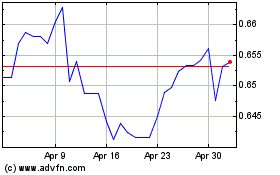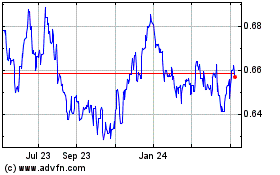Aussie Extends Slide As Australia Q2 GDP Rise Less-than-expected
September 01 2015 - 8:06PM
RTTF2
The Australian dollar continued to be weak against the other
major currencies in the Asian session on Wednesday after data
showed that the nation's economy grew at a slower-than-expected
pace in the second quarter of 2015.
Data from the Australian Bureau of Statistics showed that
Australia's gross domestic product gained a seasonally adjusted 2.0
percent on year in the second quarter or 2015. That was shy of
forecasts for an increase of 2.2 percent and down from the 2.3
percent rate in the first quarter.
On a quarterly basis, GDP added just 0.2 percent, also below
expectations for 0.4 percent and down from 0.9 percent in the three
months prior.
Meanwhile, Asian stock markets traded lower, as weak U.S.
manufacturing data and slowing growth in China added to worries
about the global economy. Additionally, lower commodity prices also
dampened investor sentiment.
Tuesday, the Australian dollar fell against its major rivals, as
downbeat manufacturing data out of China revived worries about the
outlook for global growth. The Australian dollar fell 1.39 percent
against the U.S. dollar, 1.87 percent against the euro, 2.88
percent against the yen and 0.47 percent against the Canadian
dollar. Meanwhile, the Australian dollar recovered slightly
following Reserve Bank of Australia's decision to keep its official
interest rates on hold at a record low 2 percent. But retreated
back in a short while.
In the Asian trading, the Australian dollar fell to more than a
6-year low of 0.6981 against the U.S. dollar, a 1-week low of
1.6151 against the euro and a 6-day low of 1.1008 against the NZ
dollar, from yesterday's closing quotes of 0.7013, 1.6118 and
1.1076, respectively. If the aussie extends its downtrend, it is
likely to find support around 0.66 against the greenback, 1.66
against the euro and 1.08 against the kiwi.
Against the yen, the aussie dropped to 83.83 from an early high
of 84.34. At yesterday's close, the aussie was trading at 83.72
against the yen. This may be compared to an early 9-day low of
83.63. On the downside, 81.00 is seen as the next support level for
the aussie.
The aussie edged down to 0.9246 against the Canadian dollar,
from yesterday's closing value of 0.9299. The aussie may test
support near the 0.92 region.
Looking ahead, U.K. Markits/CIPS construction PMI for August and
Eurozone PPI for July are due to be released at 4:30 am ET and 5:00
am ET, respectively.
In the New York session, U.S. private sector jobs data for
August, factory orders for July and U.S. crude oil inventories
report are slated for release.
At 2:00 pm ET, Federal Reserve releases the Beige book
report.
AUD vs US Dollar (FX:AUDUSD)
Forex Chart
From Mar 2024 to Apr 2024

AUD vs US Dollar (FX:AUDUSD)
Forex Chart
From Apr 2023 to Apr 2024
